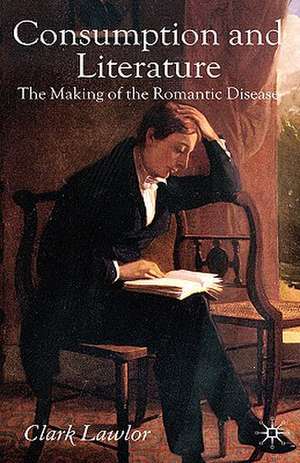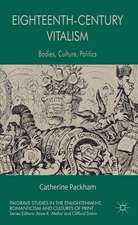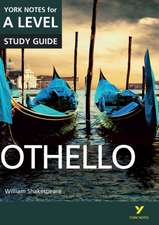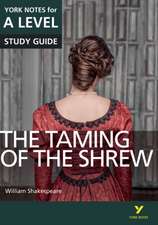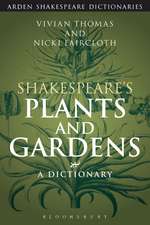Consumption and Literature: The Making of the Romantic Disease
Autor C. Lawloren Limba Engleză Hardback – 31 oct 2006
| Toate formatele și edițiile | Preț | Express |
|---|---|---|
| Paperback (1) | 693.50 lei 43-57 zile | |
| Palgrave Macmillan UK – 2007 | 693.50 lei 43-57 zile | |
| Hardback (1) | 698.74 lei 43-57 zile | |
| Palgrave Macmillan UK – 31 oct 2006 | 698.74 lei 43-57 zile |
Preț: 698.74 lei
Preț vechi: 822.05 lei
-15% Nou
Puncte Express: 1048
Preț estimativ în valută:
133.70€ • 139.97$ • 110.63£
133.70€ • 139.97$ • 110.63£
Carte tipărită la comandă
Livrare economică 07-21 aprilie
Preluare comenzi: 021 569.72.76
Specificații
ISBN-13: 9780230020030
ISBN-10: 0230020038
Pagini: 243
Ilustrații: VIII, 243 p.
Dimensiuni: 140 x 216 x 19 mm
Greutate: 0.47 kg
Ediția:2007
Editura: Palgrave Macmillan UK
Colecția Palgrave Macmillan
Locul publicării:London, United Kingdom
ISBN-10: 0230020038
Pagini: 243
Ilustrații: VIII, 243 p.
Dimensiuni: 140 x 216 x 19 mm
Greutate: 0.47 kg
Ediția:2007
Editura: Palgrave Macmillan UK
Colecția Palgrave Macmillan
Locul publicării:London, United Kingdom
Cuprins
Acknowledgements Introduction PART I: RENAISSANCE Consumption and Love Melancholy: The Renaissance Tradition The 'Golden Disease': Early Modern Religious Consumptions PART II: ENLIGHTENMENT 'The genteel, linear, consumptive make': the Disease of Sensibility and the Sentimental 'A consuming malady and a consuming mistress': Consumptive Masculinity and Sensibility PART III: ROMANTIC AND VICTORIAN Wasting Poets 'Seeming delicately slim': Consumed and Consuming Women Meeting Keats in Heaven: David Gray and the Romantic Legacy Conclusion: Germ Theory and After Bibliography Index
Recenzii
Shortlisted for the 2008 ESSE Book Award in the field of Literatures in the English Language.
'The scholarship displayed in this book - both literary and medical - is immense. Over the past decade there has been increasing interest in the relationship between literature and disease [and] Lawlor's book is a superb contribution to this field of study, as it extends the literary study of consumption back into the seventeenth and eighteenth centuries, while significantly broadening this discussion beyond the major consumptive writers... to produce a veritable canon of consumptive writing. Lawlor's book is the best history of this literary disease that we have' - Professor Alan Bewell, Department of English, University of Toronto, Canada
'This book provides much more than the title promises. It explores interpretations of consumption (pulmonary tuberculosis) from the Renaissance to the Victorian period...The result is a finely balanced exploration of historical and literary conceptions of consumption from the viewpoints of patients, physicians, and onlookers...Summing Up: Recommended.' - A. E. McKim, Choice
'Clark Lawlor's scholarly account of 'consumption narratives' is to be recommended as a well-informed and engaging contribution to the burgeoning field of interdisciplinary studies addressing the literary representation of disease...Lawlor's fascinating study provides new readings of canonical literary texts, as well as alerting us to lesser-known sources including medical texts, journals and private correspondence to provide a valuable account of the evolving aesthetics of consumption.' - David E. Shuttleton, Journal of Literature and Science
'By uncovering the link between sensitivity and genius, Lawlor aims to explain that association.'
Judith Hawley, Eighteenth-Century studies, Vol.42, No. 1, 2008
'This is a book, like the consumptives it describes, in which a slender frame belies vital force and purpose.' - James Whitehead, BARS Bulletin & Review
'The scholarship displayed in this book - both literary and medical - is immense. Over the past decade there has been increasing interest in the relationship between literature and disease [and] Lawlor's book is a superb contribution to this field of study, as it extends the literary study of consumption back into the seventeenth and eighteenth centuries, while significantly broadening this discussion beyond the major consumptive writers... to produce a veritable canon of consumptive writing. Lawlor's book is the best history of this literary disease that we have' - Professor Alan Bewell, Department of English, University of Toronto, Canada
'This book provides much more than the title promises. It explores interpretations of consumption (pulmonary tuberculosis) from the Renaissance to the Victorian period...The result is a finely balanced exploration of historical and literary conceptions of consumption from the viewpoints of patients, physicians, and onlookers...Summing Up: Recommended.' - A. E. McKim, Choice
'Clark Lawlor's scholarly account of 'consumption narratives' is to be recommended as a well-informed and engaging contribution to the burgeoning field of interdisciplinary studies addressing the literary representation of disease...Lawlor's fascinating study provides new readings of canonical literary texts, as well as alerting us to lesser-known sources including medical texts, journals and private correspondence to provide a valuable account of the evolving aesthetics of consumption.' - David E. Shuttleton, Journal of Literature and Science
'By uncovering the link between sensitivity and genius, Lawlor aims to explain that association.'
Judith Hawley, Eighteenth-Century studies, Vol.42, No. 1, 2008
'This is a book, like the consumptives it describes, in which a slender frame belies vital force and purpose.' - James Whitehead, BARS Bulletin & Review
Notă biografică
CLARK LAWLOR is Reader in English at the University of Northumbria at Newcastle upon Tyne, UK. He has edited (with Akihito Suzuki) Sciences of Body and Mind in Literature and Science, 1660-1834 (Pickering and Chatto, 2003), and has written many scholarly articles on literature, science and medicine.
